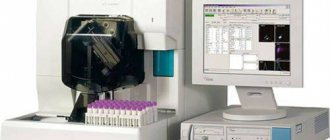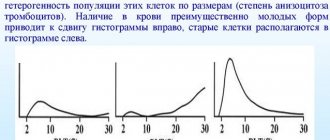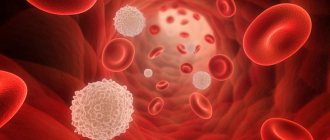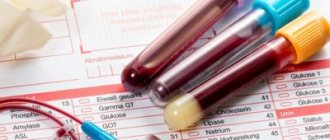Decryption features
Deciphering of blood test parameters in adults and children is carried out in order to identify all deviations, on the basis of which in the future the doctor will be able to make the correct diagnosis.
An elevated PLT index almost always indicates that the patient’s health is not all right.
Thus, a blood test can show an increased PLT indicator in the case when a patient, including a child, has arthritis and arthrosis.
In addition, this occurs in the presence of various forms of rheumatism of the joints and all kinds of anemia.
The PLT index may differ from the norm to a greater extent in case of cancerous tumors of different nature and course.
Video:
Platelets have maximum values in such complex pathologies as tuberculosis and a variety of blood diseases.
An increase in platelets almost always means a certain inflammatory process that affects the entire body as a whole.
Very often one can observe a deviation of the PLT index from the norm after surgical treatment.
If a blood test shows a low PLT index value, then the doctor looks at related factors that could lead to this result.
Very often, a decrease in the PLT value occurs due to pregnancy or a certain phase of the menstrual cycle in women.
In addition, a decrease in the number of platelets can be caused by chronic leukemia, as well as various types of anemia.
Video:
Low levels of PLT in blood fluid analysis are often observed in hepatitis and cirrhosis of the liver, as well as in some types of skin diseases.
All sorts of infectious lesions and diseases of the endocrine system can lead to this.
The doctor must definitely pay attention to the discrepancy between the PLT index and the norm. Most often, if PLT has an increased or decreased value in the analysis of blood fluid, the doctor writes the patient a referral for additional examination, which will help to most accurately identify the cause that led to a change in the number of platelets in the blood
Most often, if PLT has an increased or decreased value in the analysis of blood fluid, the doctor writes the patient a referral for additional examination, which will help to most accurately identify the cause that led to a change in the number of platelets in the blood.
Deviations
Fluctuations in indicators in one direction or another from the norm ranging from 5 to 10 units. are not critical if other blood parameters correspond to standard values. If the PMT is greatly overestimated or underestimated, while the same results are shown by the analysis when it is taken again after some time, this is a sign of pathological processes in the body.
Thrombocytopenia
A decreased PLT is called thrombocytopenia. This means that the blood is thin and lacks platelets. In addition, if PLT is low, this may indicate the following diseases and pathological processes in the human body:
- Diseases and disorders in the functioning of the bone marrow. This category also includes oncological diseases of the blood - leukemia, chemotherapy and radiation therapy, and the presence of metastases in the bone marrow. A decrease in PLT can be provoked by taking certain medications that affect the bone marrow - some types of antibiotics, anti-inflammatory drugs.
- HIV.
- Alcohol addiction.
- Cirrhosis of stagnant type.
- Insufficient amount of folic acid in the blood.
- Autoimmune diseases accompanied by platelet destruction.
Important information: What is the leukocyte blood count and what is it needed for (table of decoding norms for adults)
A low platelet count is observed during bleeding or in the case of a previous infusion of red blood cells.
Symptomatic picture:
- bleeding gums;
- long and difficult healing of wounds and abrasions;
- in women - prolonged and heavy discharge during menstruation;
- frequent nosebleeds;
- the appearance of petechiae on the skin and mucous membranes, which are a red rash;
- the appearance of pinpoint hemorrhages.
Low PMT is extremely dangerous for humans. The likelihood of complications and their severity depend on how much this parameter deviates from the norm:
- With minimal discrepancy, if PLT is from 100 to 50, there are no symptoms, the likelihood of bleeding is minimal.
- If the indicator is from 50 to 20, the patient has increased bleeding of the gums, bleeding can occur after injuries or wounds.
- PLT less than 20 - there is a possibility of sudden spontaneous bleeding.
- If the indicator is less than 5, the likelihood of extensive bleeding is extremely high and poses a threat to human life.
Reference values
- The interpretation rate for children varies from 200 to 500 (x109/l) depending on gender and age.
- The standard for interpreting the result for adults is 150-400 10 9 / l, regardless of gender.
In all other cases, changes in blood counts are a reason to consult a doctor.
Normal indicators
Thrombocytosis
Thrombocytosis is characterized by an increase in the number of platelets in the blood above the confidence interval.
- An incomplete list of possible causes of thrombocytosis:
- Cirrhosis of the liver
- Hemolytic anemia
- Reactive thrombocytosis in response to recovery from treatment of thrombocytopenia with B12 and folic acid supplementation
- Oncological diseases
- Lymphogranulomatosis
It is worth noting that the risk group includes elderly people over 60 years of age, children, and newborns.
Attention! A change may occur due to recent surgery or during drug treatment, for example, when using non-steroidal anti-inflammatory drugs. Partial list of symptoms of thrombocytosis:
Partial list of symptoms of thrombocytosis:
- Headache
- Nose and stomach bleeding, in females - uterine bleeding.
- Decreased visual acuity
- Tingling or numbness in the extremities
- Vegetovascular disorders
- The appearance of edema
PLT file summary
We have ten existing software programs associated with PLT files (typically software from Tecplot, Inc. known as Tecplot 360), and they can be categorized under three main file types. Traditionally these files are in the Tecplot Binary Data File format.
These files are classified as Data Files or Vector Image Files. The main part of the files belongs to Data Files.
PLT files can be viewed using Mac, Linux, and Windows operating systems. They are typically found on desktop computers (and some mobile devices) and allow you to view and sometimes edit these files.
The PLT file extension has a popularity rating of "Low", which means that these files are generally not found in most user file stores.
PLT indicators in children
Monitoring the average platelet volume in the blood of children is very important. If the PLT level has decreased, then the following reasons for the formation of this condition in children are identified:
- allergies to drugs;
- intoxication;
- thyrotoxicosis;
- blood diseases;
- parasitic and viral infections.
If platelets are elevated, then the reasons that cause this condition in children can be very diverse. Thrombocytosis is divided into primary and secondary. The first is characterized by the production of platelets with an altered structure by brain stem cells. This can be observed in a child with leukemia.
Secondary (reactive) in children develops due to a certain pathological process that contributes to disruption of the production of the cells presented. The main reasons for the formation of reactive platelets in a child are as follows:
- heavy operations;
- splenectomy;
- sudden bleeding in a child;
- osteomyelitis;
- anemia;
- fractures of tubular bones;
- pulmonary infections;
- malignant diseases that have affected the child’s body;
- some drugs.
Analysis and norms
How many platelets are in the blood plasma is determined during a clinical analysis. It is also called a general blood test. The material is collected from the patient's finger. After this, the resulting blood is mixed with special reagents. The final stage of the study is to count the number of platelets using a magnifying device.
Before taking blood, you need to fulfill the standard requirements that are set for any analysis. You need to refrain from eating, avoid heavy physical activity and stress. If the child is small, he can be given clean water. In infants, material is collected 2 hours after breastfeeding. Parents should try to calm their child before the test.
The number of platelets in a child’s blood must be constantly monitored; it is especially important to get tested if the baby is too tired, or you notice that his nose often bleeds or bruises appear. It should also be a reason to consult a doctor if your child has increased bleeding gums, suffers from dizziness, and has lost his appetite.
The plt standards for children are as follows:
| Child's age | Average norms |
| Newborn baby in the first week of life | 100-420 thousand/ml3. |
| Children under 1 year | 145-351 thousand/ml3. |
| Children under 15 years old | 179-321 thousand/ml3. |
| Adolescent girls 15-18 years old (with the onset of menstruation) | 74-221 thousand/ml3. |
What do deviations from the norm indicate?
PLT structures, as stated earlier, are cells with increased sensitivity to organismal changes. Quantitative fluctuations that go beyond acceptable limits may indicate a whole range of diseases.
The level of PMT content is reduced
If the platelet count is below 130–140 10^9/l (not counting the gestation period and menstruation), then, with a high degree of probability, one of the pathologies is developing:
Why is RFMC elevated in a blood test?
- Hepatitis.
- HIV.
- Mononucleosis.
- Herpes.
- Flu.
- Tonsillitis.
- Epstein-Barr virus.
- Avitaminosis.
- Scleroderma.
- ARVI or acute respiratory infections.
- Tuberculosis.
- Hypothyroidism.
- Gaucher's disease.
- Hemophilia.
- Uremia.
- Chicken pox.
- Radiation sickness.
- Dermatomyositis.
- Increased metastasis.
- Werlhof's disease.
- Heavy metal poisoning.
- Malaria.
- Colitis.
- Hemorrhagic vasculitis.
- Rubella.
- Cirrhosis of the liver.
- Disseminated intravascular coagulation syndrome.
Very often, reduced levels of PLT are observed in people suffering from autoimmune diseases, for example, Sjögren's syndrome, sarcoidosis, diabetes mellitus, uveitis, glomerulonephritis, pemphigus, Hshimoto's thyroiditis, systemic lupus erythematosus, psoriasis, vitiligo, myasthenia gravis or Crohn's, Addison's, Graves. Low platelet counts are also detected in blood tests in children with osteomyelitis or fractures of long bones, which include the shoulders, forearms, as well as the femurs, fibula, and tibia.
The meaning of low or low platelets in a blood test
The circulatory system affects all organs of the human body, and the study of blood elements reflects the state of health. As long as the number of blood cells is within normal limits and they fully perform their functions, pathologies and deviations in the functioning of the body do not occur. If red blood cells or platelets are low, the doctor will prescribe an additional examination to determine the cause of the deviation. A low level of platelets in the blood is a dangerous condition that requires immediate treatment.
Blood consists of various small cells, each of which plays its own role. Platelets are small lamellar cells (blood plates) that, due to their shape, can easily cover sites of vascular damage. These flat, disc-shaped particles are only 0.002–0.004 mm in diameter and are visible under a microscope.
These cells perform a number of very important functions.
- Closing wounds and stopping bleeding. An injury or cut that signals tissue damage causes a rush of platelets to the wound. Thanks to special chemical compounds, blood plates stick together and attach to the walls of damaged vessels.
- Participation in metabolism and blood restoration. Lamellar cells transport serotonin, some enzyme compounds and other substances.
- Immune support. With sufficient blood cell production, resistance to infections and viruses is at a normal level. If your platelet count drops, your immune system may also decrease.
- Lamellar blood cells remove destroyed viruses and antigens from the body.
High or low levels of platelets and other indicators may indicate the presence of serious diseases. What does it mean? First of all, you should not rush to conclusions or self-medicate. A hematologist deals with blood disorders. A qualified specialist can explain why deviations from the norm were found and how to normalize the indicator.
Any abnormalities in the blood test can be dangerous. An increase in the number of platelets can lead to the formation of blood clots, while a decrease in platelets in the blood can cause a blood clotting disorder. The indicator depends on age and can change during the day.
- In infants in the first year of life, the indicator is 100–420*10 9 /l
- For adults, the norm is in the range of 180–350*10 9 /l
- A platelet level of 150–380*10 9 /l may indicate that the patient is pregnant or menstruating.
Symptoms of decreased levels of lamellar blood cells appear physically. As a rule, the main manifestations of thrombocytopenia are associated with heavy and prolonged bleeding. Even minor tissue damage in an adult can give rise to an urgent visit to the doctor. Patients complain of frequent new bleeding, blood loss from cuts and injuries, heavy menstruation, and the appearance of hematomas with slight pressure. If left untreated, symptoms worsen and may result in bleeding that cannot be controlled, stroke, and subsequent disability.
Low platelets in the blood
The condition when plt is reduced is called thrombocytopenia. Their quantity is less than 180x109/liter. Thrombocytopenia is an increased risk of bleeding. With a slight decrease in plt, bleeding occurs only with open injuries, lasts a long time, and is difficult to stop the bleeding.
If the platelet level is less than 60x109/liter, bleeding from the nose and gums occurs. Even with minor injuries, large bruises appear.
Reasons for decreased PLT levels
Plt in the blood test is reduced if the maturation of megakaryocytes in the bone marrow is impaired. This is primary thrombocytopenia. Reduced blood platelets may be associated with their rapid destruction in the spleen when its function increases.
Low platelets are observed in the following diseases:
- adenoviral infection;
- viral hepatitis;
- radiation sickness;
- acute leukemia;
- metastases in the bone marrow;
- anemia associated with a lack of vitamin B12 and folic acid;
- some hereditary diseases - Fanconi syndrome, Wiskott-Aldrich, Bernard-Soulier.
In these diseases, the formation of blood platelets is disrupted.
The platelet count decreases if they are exposed to destructive factors:
- autoimmune diseases;
- blood transfusion;
- allergic reaction to drugs;
- action of viruses;
- mechanical heart valves.
Temporary thrombocytopenia is observed with excessive consumption of cells by the body - with acute bleeding, disseminated intravascular coagulation syndrome, thrombocytopenic purpura.
What to do if your platelet count is low
If the reason for the decrease in blood platelets is the hyperfunction of the spleen, it is removed. In other situations, the underlying disease is treated. For viral infections, antiviral drugs are prescribed. For leukemia and bone marrow metastases, chemotherapy and radiation are performed. For anemia, folic acid and vitamin B12 are prescribed.
People with thrombocytopenia need to avoid traumatic situations. When plt levels are low, bleeding can cause even minimal damage. Almost all types of sports and heavy physical activity are contraindicated for such patients. In a blood test, plt is platelets, the norm is 180-320x10x9/liter. For women, the norm is lower during pregnancy and menstruation. In men, the rate increases with intense sports and heavy physical work. Children have more plt in their blood than adults. The indicator levels off by age 15. The blood test is interpreted by a doctor.
Platelets general information
Bizzocero bodies (plt), or more precisely, their predecessors megakaryocytes, originate in the bone marrow, like all blood cells. Blood plates are obtained from a cell with a large nucleus (megakaryocyte) using the separation method. Platelets are sensitive to damage to the inner lining of the vessel. When the endothelium (the epithelium covering the inside of the vessel) is injured or immune damaged, the collagen of the basement membrane is exposed. This attracts platelets to the site of injury.
First, platelet adhesion (sticking) to the vessel wall occurs, and then aggregation (accumulation of them). Then other factors influencing coagulation are involved. Bizzocero bodies have a membrane containing a phospholipid matrix that interacts with plasma proteins involved in blood clotting.
Plt, as Bizzocero bodies are designated in a blood test, have granules inside that contain a factor for restoring the integrity of the vessel - platelet germ factor. This factor, found in alpha granules, promotes the proliferation of connective tissue cells and smooth myocytes.
Type I plt alpha granules upon degranulation release thrombospondin and antiheparin factor. Thrombospondin interacts with the plasma protein fibrinogen. Heparin is a substance that prevents blood clotting. Blood platelets also contain dense granules containing adenosine diphosphoric (ADP) and adenosine triphosphoric acid (ATP). ADP causes aggregation by acting on adenosine receptors on blood platelets from the bloodstream.
Antiplatelet drugs (Caffeine, Aspirin, Plavix) block these receptors, preventing pathological thrombus formation and vascular obstruction by blood clots. Adrenaline and serotonin, released by Bizzocero bodies when the endothelium is damaged, promote vasoconstriction to reduce blood loss. Calcium from the granules activates the formation of thromboxanes and prostaglandins.
Conducting research
For men, women and children, the platelet rate is different, which means that the doctor, when studying the tests, must take into account some of the physiological characteristics of the patient.
Platelets are quite variable elements of blood. They constantly change their meanings throughout a person’s life.
In addition, during the course of a day, for many people, the protein norm can change its values several times.
The PLT index can be influenced by factors such as, for example, excessive physical activity, pregnancy, and the menstrual cycle in women.
Meanwhile, the PLT index can be increased relative to its norm for some other reasons, which already fully indicate the presence of a pathological condition in the body.
Deciphering the PLT blood test allows you to determine the nature of the cause that led to a deviation from the norm in one direction or another.
An increased or, conversely, decreased PLT index may indicate the development of quite serious pathologies in a person, which, if timely and adequate measures are not taken, can lead to malfunctions in the functioning of the body as a whole.
Video:
When making a diagnosis and prescribing a course of treatment, the doctor, along with the platelet level, also takes into account many other blood indices obtained from the results of the analysis.
In order for a blood test to show the most reliable result, when all indicators correspond to their true values, it is necessary to follow a number of simple recommendations.
On the eve of the study, it is not recommended to eat highly fatty and fried foods.
In addition, the day before donating blood, it is better to stop taking various medications, which can greatly reduce the reliability of the final result.
Coffee, alcoholic drinks, and smoking can also distort the values of indicators. The platelet level has its own specific norm, with which the laboratory compares the data obtained.
| Age | PLT level, x109/liter of blood |
| Newborn | 100 – 420 |
| Up to a year | 150 – 350 |
| After a year and adults | 180 – 320 |
When deciphering a blood test, the PLT index norm is taken, with which the resulting indicator is checked.
All deviations are recorded in the final report, which is sent to the attending physician after the study.
The doctor who issued the referral for analysis carefully examines all the data received from the laboratory and makes a final diagnosis based on them.
In some cases, in order to more accurately determine a particular pathology, additional diagnostics may be needed.
How the research is carried out
Knowing what PLT is in a blood test and how important it is to get a reliable result, you need to properly prepare for the study. To do this, you must adhere to the standard recommendations for such analyzes - donate biological material only in the morning, exclusively on an empty stomach. Before taking blood, do not smoke, be in a calm physical and psycho-emotional state. Blood is taken from the ring finger.
The biological material collected in a test tube is placed in a centrifuge, where the blood cells are separated from the liquid. Determination of characteristics and calculation of PMT can be carried out manually or using automated instruments. The results of the analysis are presented in the form of a histogram with a curve.
Assessment of coagulogram indicators
The purpose of the analysis is to determine the rate of coagulation of venous blood using the Lee-White method. This indicator is necessary to determine the first stage of hemostasis to assess the formation of prothrombinase.
The method involves assessing the levels of enzymes in the blood, such as thrombokinase, using simple numerical indicators.
3 ml of blood is collected and divided into 3 tubes of 1 ml each. The blood is heated at a temperature of 37 degrees, after which the test tube is inserted into a stand at an angle of fifty degrees. After this, using a stopwatch, the laboratory assistant counts the time it takes for the blood to clot. The measurement time is on average 2-5 minutes.
The procedure is considered completed at the moment when the blood completely clots and stops flowing out when the tubes are tilted.
Platelet aggregation
Due to the specifics of the study, at the moment no laboratory can give an absolute guarantee of a reliable result.
Normal values
The importance of platelets varies depending on age, gender, and the presence of special physical conditions. PLT in a blood test, the norm in adults (both men and women), regardless of age, should be in the range from 100 to 450*10^9/l.
The rate of PLT in a child depends on the age group:
- from birth to 14 days - from 144 to 449;
- from 14 days to 1 month - from 249 to 586;
- from 1 to 2 months - from 229 to 597;
- from 2 months to six months - from 244 to 580;
- from six months to 2 years - from 206 to 459;
- from 2 to 6 years - from 189 to 403;
- from 6 years - from 140 to 400.
In the female body, hormonal changes constantly occur due to menstruation, pregnancy, and menopause. Therefore, in women, platelet counts may change throughout life. Normal indicators for women depending on different physiological conditions: 1st trimester of pregnancy - from 170 to 360, 2nd - from 160 to 340, 3rd - from 140 to 330, 1-3 days before birth - from 160 to 420. First month of breastfeeding feeding - from 135 to 400. During menstruation, PLT ranges from 85 to 210.
Normal indicator, what to pay attention to when conducting research
The normal PLT value of a blood test is generally considered to be:
- The particle count in humans is 180-320000,
- The value is set to one liter for an adult.
Otherwise the following applies:
- Blood for PLT analysis in a child is slightly different,
- The first data value for a newborn baby is set at 100-420,
- For a child under one year of age, the value is normalized at 150-350,
- For children who are already one year old, the particle indicator is set at the same level as that of an adult.
Normal PLT value
How to normalize an indicator
The test result, which shows low platelets in the blood, is not the only test. To find out why there are not enough blood plates and prescribe the correct treatment, the doctor prescribes a full examination. Diagnostic tools include biochemical analysis, ultrasound, biopsy and other methods.
To prevent the tragic consequences of low platelet levels, which even include disability, and in some cases threaten the patient’s life, the influence of external factors should be excluded and immediately consult a doctor.
First of all, you should stop taking blood thinning medications (Aspirin, Ibuprofen, etc.).
Drink less or eliminate alcohol completely. It is also necessary to eliminate the deficiency of iron and vitamin B12 in the daily diet and eat more liver, red meat, buckwheat porridge, nuts, pumpkin, etc. The doctor may recommend revising your daily routine. If too little time is allocated for proper rest, hematopoietic function may be impaired.
It is very important to consult a doctor in a timely manner and undergo the necessary medical examination
Grandmother's time-tested recipes can correct the lack of platelets in the body. However, before wondering what to do to normalize the indicator at home, you should consult with your doctor. It is strictly forbidden to use alcohol-containing tinctures.
Nettle infusion gives a good effect. 10 gr. 250 ml of dry crushed leaves of pharmaceutical nettle are poured. boiling water and boil for 3-5 minutes. The broth is poured into a small thermos and allowed to brew for half an hour. The finished infusion is cooled to an acceptable temperature and consumed half a glass before meals.
Not only healthy, but also tasty infusion is prepared from a dry mixture of herbs. Grind 1 part chamomile flowers, 2 parts nettle leaves, 3 parts rose hips in any available way (blender, coffee grinder, etc.) into powder. Place the ingredients in a 1-liter thermos and top up with boiling water. After 1 hour, filter the broth, add freshly squeezed juice of half a lemon and 1 tbsp. a spoonful of natural flower honey. You should take herbal tea three times a day, half an hour before meals.
As part of an annual physical, the patient provides a blood sample for testing, which can help detect low platelets and other abnormalities. This analysis is necessary for both healthy people and patients with chronic diseases. A slightly reduced or significantly lower platelet count is a reason to immediately consult a hematologist. Timely detection of a disease or disorder gives the doctor the opportunity to prescribe the most effective treatment and avoid complications.
PLT in blood test - what is it?
To diagnose pathologies, the most common research method is a general blood test. With its help, the doctor can make a conclusion about the general health of the patient. The study allows us to identify the quantitative composition of blood. PLT in blood test, what is it?
PLT in blood test - what is it?
Platelets are the name given to platelets. Using laboratory analysis, their quantity is determined. And the analysis itself is called “determining PLT in a blood test.” A qualified conclusion about platelet pathology can be made by a doctor. But everyone should know their normal content in the bloodstream.
PLT functions
Platelets are small blood cells that do not have a nucleus and are disc-shaped in configuration. They are produced in the bone marrow and play an essential role in blood clotting. They restore blood vessels, nourish them and participate in stopping bleeding. Functions of blood bodies:
- PLT platelets seal the rupture site, forming a primary defense: the platelet clot.
- Growth factors are identified. They activate cell division and growth in areas of damage.
It has been established that with the help of platelets the body heals and regenerates tissue. A decrease in PLT levels leads to bleeding, and their excess leads to thrombosis. The growth of clots in the vascular system is caused by:
- • to damage to the vessels of the cerebral cortex,
- • blockage of the pulmonary arteries,
- • to necrosis of the tissues of the arteries of the heart,
- • blockage of the lumens of blood vessels,
- • transformative,
- • platelet,
- • insulin-like growth factor,
- • growth factor of vascular endothelium, epithelium and fibroblasts.
Disorders of platelets are called thrombocytopathy. It is characterized by:
- • increasing concentration,
- • reduction in quantitative composition,
- • impairment of activity.
How is the analysis carried out?
Platelet levels fluctuate throughout the day. For the analysis to be reliable, it is carried out on an empty stomach in the morning. The analysis is carried out from 7:30 to 11 o'clock. Before performing the analysis you cannot:
- • drink tea and coffee the day before,
- • drink drinks with alcohol,
- • do not smoke two hours before the test,
- • do not consume fatty, fried and salty foods beforehand.
The last meal should be at least twelve hours later. Before the study, you should not overload yourself with heavy physical work. Physical activity will increase the concentration of platelets in the vessels. The study is carried out in the clinic to which the patient is assigned. Venous or capillary blood collection is a quick and painless procedure. It is necessary to adhere to the rules for the study to be reliable. Ignoring these rules may affect the final results and distort the data. Determining the number of platelet cells in the bloodstream helps to accurately determine the dysfunction of the most important organs and make the correct diagnosis.
PLT: transcript
After donating blood for a general examination, an analysis is carried out in a specialized laboratory to determine the quantitative content of platelets in the patient. An additional biochemical research method can also be carried out. Deviations from the normal value indicate emerging pathologies. Normal values differ between children and adults. They are not the same for women and men.
PLT analysis norm
What is the normal value of platelet concentration in the bloodstream in a person? The level of PLT in the blood is shown in the table. Indications are given per 1 liter of blood, based on the age of the person being examined.
Elevated platelets in the blood
An increased amount of plt in a general blood test is called thrombocytosis. The level of blood platelets exceeds 320x10x9/liter. Thrombocytosis is accompanied by a high risk of blood clots in various organs.
Thrombocytosis itself does not have significant symptoms. When a blood clot forms, the blood supply to the organ where it is located is disrupted. The function of the organ is impaired. If it is the brain, a stroke develops. A blood clot in the heart leads to myocardial infarction. A blood clot in the pulmonary arteries causes death within minutes.
Causes of increased platelets
There are two mechanisms for increasing platelet levels:
- primary, when many megakaryocytes are formed in the bone marrow;
- secondary, arising against the background of any disease.
Primary plt in a blood test is increased when:
- essential thrombocythemia, the cell level increases to 2000-4000x109/liter;
- erythremia;
- chronic myeloid leukemia.
Secondary causes of high platelet counts:
- rheumatism;
- rheumatoid arthritis;
- tuberculosis;
- chronic liver diseases;
- inflammation of the intestines with the formation of ulcers;
- bone inflammation;
- some types of cancer.
Platelets increase after severe bleeding, extensive surgery, or removal of the spleen.
What to do when plt level increases
Diseases accompanied by primary thrombocytosis are treated with hormonal drugs, radiation, and blood transfusions. Rheumatism is treated with antibiotics. For rheumatoid arthritis, steroids and NSAIDs are prescribed. Inflammatory diseases are treated with antibiotics, antiviral drugs, and steroids.
There is no special diet to reduce the number of blood platelets. It is recommended to limit the consumption of tomatoes. The diet is enriched with fresh vegetables and fruits, and red meat must be present.
Low blood platelets
Reasons for a decrease in platelets may be associated with infectious diseases, congenital abnormalities, or the development of serious diseases. Among the congenital abnormalities, Gaucher disease is distinguished. Also, a lack of platelets can be caused by Werlhof's disease, the cause of which remains unclear to date.
- The herpes virus can cause low platelet levels. Symptoms of the disease are pronounced and appear in the form of small ulcers on the face or genitals. The diagnosis can be confirmed using a blood test.
- Infectious diseases that cause an enlarged spleen cause the level of blood platelets to decrease.
- A common cold, laryngitis or acute respiratory viral infection causes a low level of platelets in the blood, but this is a temporary phenomenon. After recovery and death of harmful bacteria, the level of lamellar cells returns to normal.
- Systemic autoimmune diseases (lupus, etc.) are dangerous because the body can mistake its own cells for foreign ones and begin to fight them. As a result, there is a decrease in platelet levels.
- The platelet count will decrease when there is blood cancer or cancer metastases have spread to the bone marrow.
- Inflammatory processes in the liver (hepatitis) cause an increase in its volume and a decreased content of platelets in the blood.
- Low platelets in the blood can be a consequence of mononucleosis. Infection with this disease occurs as a result of the exchange of saliva and other bodily fluids with a sick person.
- Low platelets in the blood are a concomitant factor in HIV. Damage to the immune system affects blood cells and causes a decrease in the amount of essential elements in the body.
- Platelet volume is reduced in bone marrow lesions that interfere with the production of blood cells.
- Overuse of medications can lead to blood thinning. Systematic use of Aspirin, Heparin and other drugs can cause low platelet counts in the blood.
- In case of heavy metal poisoning, a low number of blood platelets is observed.
- Platelets below normal levels are caused by systematic and excessive alcohol consumption.
- A platelet count below normal is sometimes caused by poor nutrition. Eating foods that can thin the blood (onions, garlic, ginger, cherries, lemon, etc.) leads to minor deviations in the analysis.
What does a decrease in platelets mean?
A significant decrease in platelet levels is recorded, starting from below 100 thousand units/μl (mild thrombocytopenia). In the range from 20 to 50 thousand units/μl, spontaneous hemorrhages not caused by external causes (moderate thrombocytopenia) occur. Life-threatening blood loss occurs when PLT in the blood is less than 20 thousand units / μl (severe thrombocytopenia).
A decrease in PLT may occur if:
- the bone marrow produces an insufficient number of platelets (a rare phenomenon);
- platelets die too quickly (this condition occurs in most victims).
Causes:
- autoimmune diseases;
- leukemia;
- diseases of the endocrine system;
- viral and bacterial infections;
- alcoholism and, as a result, depression of the liver and spleen;
- malnutrition;
- prolonged or uncontrolled use of certain medications;
- bone marrow lesions (metastases or as a result of taking drugs);
- irradiation.
Thrombocytopenia causes the walls of blood vessels to become inelastic and unusually fragile. This is a source of causeless internal bleeding and severe health problems requiring hospital observation.











